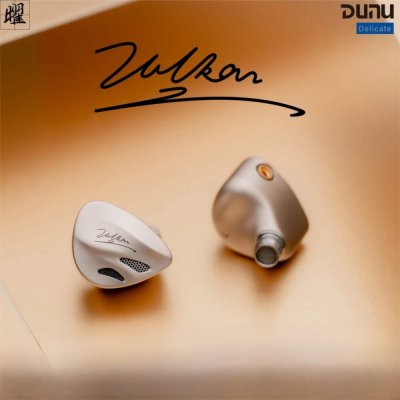Dunu Vulkan 2 and Yu9 Que use 2DD+6BA and 1DD+3BA driver setups respectively. Dunu Vulkan 2 costs $360 while Yu9 Que costs $409. Yu9 Que is $49 more expensive. Yu9 Que holds a clear 0.9-point edge in reviewer scores (7.3 vs 8.1). Yu9 Que carries a user score of 8.5. Yu9 Que has significantly better bass with a 1.2-point edge, Yu9 Que has slightly better mids with a 0.3-point edge, Yu9 Que has significantly better dynamics with a 1.2-point edge, Yu9 Que has slightly better soundstage with a 0.4-point edge and Yu9 Que has slightly better imaging with a 0.3-point edge.
Insights
| Metric | Dunu Vulkan 2 | Yu9 Que |
|---|---|---|
| Bass | 7 | 8.2 |
| Mids | 8 | 8.3 |
| Treble | 7.8 | 8 |
| Details | 7.7 | 7.8 |
| Soundstage | 7.7 | 8.1 |
| Imaging | 7.6 | 7.9 |
| Dynamics | 6.6 | 7.8 |
| Tonality | 7.6 | 8.3 |
| Technicalities | 7.9 | 8 |
Dunu Vulkan 2 Aggregated Review Score
Average Reviewer Scores
Average Reviewer Score:
7.3Generally Favorable
Yu9 Que Aggregated Review Score
Average Reviewer Scores
Average Reviewer Score:
8.1Very Positive
Reviews Comparison
Dunu Vulkan 2 reviewed by Jaytiss
Youtube Video Summary
The Dunu Vulkan 2 boasts exceptional build quality and comfort. Its shell design is praised as extremely nice at any price, fitting securely with a flat two-pin connector, metal nozzle, and helpful anti-tragus catch. The comprehensive accessory package is a major plus, including a pocketable case, 6.3mm and 3.5mm connectors, a cleaning brush, IEM booties, two sets of tips, and a particularly supple cable featuring a screw-lock termination for easy swapping. Everything about the physical presentation feels solid and well-executed.
Sonically, the Vulkan 2 represents an improvement over the original, offering a presentation focused on detail retrieval and a well-done upper mid-range and treble. The overall signature is slightly bright and energetic, leaning towards a treble-focused tonality while still providing sufficient bass to feel rich and supported, though it lacks a thunderous low-end impact. This results in a slightly lean sound that some might find a touch brittle, but the tactful tuning delivers great detail, nice mids, and a presence region comparable to sets like the Moondrop Meteor. Comparisons reveal it has less bass than the DUNU Brain Dance (especially with an impedance adapter) or the Kiwi Ears Astral, but its mid-range and treble presentation are standout strengths.
Despite the slightly lean bass response, the Vulkan 2 emerges as a strong package at its price point. The combination of its superb build, comfort, excellent accessory set, and a detailed, engaging sound signature focused on mids and treble makes it highly compelling. It's recommended for listeners seeking a studio-monitor style presentation rather than a bass-heavy experience. While not a perfect one-and-done for everyone, and a bass adjustment feature like a rumble switch or impedance adapter would be welcome, it stands as a near-endgame option offering great value and quality within the $300-$400 range.
Jaytiss Youtube Channel
Buy Dunu Vulkan 2 on HiFiGO
Ad
Price: $359.99
Buy Dunu Vulkan 2 on HiFiGO
Yu9 Que reviewed by Jaytiss
Youtube Video Summary
The YU9 Que sports a premium, durable resin shell in pure black with a metallic-feeling faceplate and a comfortable design featuring an anti-tragus catch. While the build itself feels handsome and unique, the included cable is criticized as wimpy and unpleasant, with a strong suggestion to upgrade it. Accessories are deemed solid, including a nice selection of tips and a particularly praised case with a soft, luxurious interior.
Sonically, the YU9 Que earns immense praise for its exceptional tuning, described as clean, resolute, and non-fatiguing. It delivers strong, textured bass that avoids being overwhelming, coupled with extremely well-done upper mids. While not class-leading in technicalities like micro-detail or instrument separation, its tonal balance is considered sophisticated and reminiscent of far more expensive sets like the Annihilator, even surpassing the Monarch MKII in tuning preference. It's highlighted as a fantastic all-rounder with a smooth, agreeable signature suitable for long listening sessions.
Despite its modest single dynamic driver + 3BA configuration and $409 price point, the YU9 Que is declared a very special and unique IEM, worthy of the hype it received. The review concludes it's a price leader and a highly competent package from a small brand, offering outstanding value and a beautiful, well-executed design that makes it an easy recommendation for those seeking a smooth, non-fatiguing sound.
Jaytiss Youtube Channel
Dunu Vulkan 2 reviewed by Paul Wasabii
Youtube Video Summary
Vulkan 2 is an 8-driver hybrid (2DD+6BA) tuned for a mids-forward presentation, echoing the EJ07 approach but with DUNU's brighter, more present upper range. A modest 5 dB bass shelf and a mid-bass dip keep the low end clean and quick while pushing attention to the heart of the mix. Vocals come through emotive, textured and open; female voices gain extra energy from the upper-mids, while male vocals can pick up a touch of BA edge. This is not aimed at V-shaped preferences—engagement is built around the mids rather than big bass or treble fireworks.
Bass focuses on quality and control—tight hits, fast decay, no lingering bloom—building clear layers into the midrange. The treble is polished and natural with a gentle upper-treble roll-off: no fake air, no grain, and enough presence to surface detail without harshness. Resolution presents as resolving in a natural way and is source-revealing; added warmth or EQ tends to detract from the coherence of the stock tuning.
Stage is neat and three-dimensional with clean separation, good depth and stable imaging, though a bit more intimate than EJ07. Overall it reads as a refined, slightly brighter spin on that recipe: standout mids, disciplined and speedy bass, and a tasteful top end that favors realism over spectacle—engaging for mid-centric listeners, but genre-dependent if heavy mid-bass is required.
Paul Wasabii Youtube Channel
Yu9 Que reviewed by Paul Wasabii
Youtube Video Summary
At ~$400, YU9 Audio Que sets a new bar for the bracket: a 1DD+3BA hybrid with a modest bass shelf, slightly forward mids, and linear treble extension that sounds more speaker-like than typical IEMs. The presentation is exceptionally polished and quiet-backgrounded, yielding crisp separation, convincing imaging, and staging in depth, width, and height that resembles far pricier gear.
The low end brings tactile mid-bass impact with deep, controlled sub-bass, pairing naturally with that extended, peak-free top end; the result is a true playlist killer across EDM, rock, vocal, and classical. Nitpicks exist: mids can sit a touch forward depending on track and the set rewards a slightly higher volume and a secure, deeper fit, while V-shape fans may find it too boring.
Compared with favorites like Dusk, Cadenza 4, and Volume S, Que keeps their strengths but fixes common complaints by delivering fuller bass weight, cleaner openness, and more realistic attack and dynamics. It does not need giant-killer claims to stand out; at this price it is simply class-leading.
Paul Wasabii Youtube Channel
Dunu Vulkan 2 reviewed by Jays Audio
Youtube Video Summary
Initial skepticism about the Dunu Vulkan 2's significant scoop in the 150-200Hz range quickly faded upon listening. This scoop typically kills rhythmic intensity, slam, and weight, making genres like hip-hop or EDM sound anemic. However, the Vulkan 2 makes it work through a tamer upper midrange compared to Harman targets and a filled-in lower midrange past 200Hz. This creates a smaller contrast (around 7dB difference between peak and mid-bass) than expected, preventing the sound from becoming overly thin or shouty. The result is a surprisingly balanced, neutral, and vocal-centric tonality that excels with artists like SZA, Frank Ocean, or Lana Del Rey on genres such as indie rock, ballads, and acoustic tracks.
This tuning comes with clear trade-offs. The lack of sub-bass is the most significant limitation, making the Vulkan 2 unsuitable for hip-hop, EDM, rap, or movies where rumble and slam are essential. Boosting the sub-bass wasn't feasible without creating an even bigger scoop or ruining the intended neutral, clean vocal focus. Technically, it offers good layering, separation, and a slight bite in transients, with detail and resolution comparable to sets like the Dusk, though not class-leading for its price. It scales well with volume on its preferred genres (around 75-80dB), sounding clearer and more engaging, but falls flat at lower volumes or on energetic pop/EDM where the missing low end hurts balance.
Compared to other neutral/vocal sets like the P50 or Studio 4, the Vulkan 2 is less all-rounded due to its bass deficiency, though it offers slightly better scaling and vocal focus. Bass-centric IEMs like the Odyssey are far superior for low-end engagement. While the vocal presentation is clean and enjoyable within its niche, the $360 retail price is hard to justify. Alternatives like the Volume S (for male vocals) or the Arcanis (for a more immersive, special vocal experience) are better all-rounders that also excel with vocals. The Vulkan 2 becomes a more interesting proposition only if found significantly discounted around $200 as a specialty set for vocal-forward, less bass-dependent genres.
Jays Audio Youtube Channel
Yu9 Que reviewed by Jays Audio
Youtube Video Summary
YU9 Que presents a balanced, almost neutral tuning with a tasteful touch of mid-bass for warmth and punch. Treble is clean and controlled—more clarity than “sizzle”—so detail comes through without harshness, while mids keep vocals natural rather than forward or thin. Technical performance sits in the “solid for the price” camp: separation and imaging are tidy, but not the kind of hyper-etched sparkle that chases wow factor.
In practice, it shines with slower pop, R&B, acoustic and vocal-centric tracks where its coherence and smoothness pay off; those seeking big sub-bass drama or ultra-aerated treble fireworks may find it a touch polite. Versus brighter, more contrasty sets, the Que trades spectacle for musicality and long-session comfort, making value hinge on whether a refined, low-fatigue signature is preferred over maximum excitement at the price point.
Jays Audio Youtube Channel
Dunu Vulkan 2 reviewed by Head-Fi.org
Yu9 Que reviewed by Head-Fi.org
Dunu Vulkan 2 reviewed by Web Search
The Dunu Vulkan 2 employs a dual dynamic driver setup—10mm for sub-bass and 8mm for mid-bass—each in isolated chambers to reduce interference and enhance low-end articulation. Its four-way hybrid crossover (physical + electronic) ensures coherent frequency transitions between the dedicated sub-bass, bass, midrange, and treble drivers, minimizing distortion. The tuning prioritizes textural depth over sheer impact, with sub-bass extension excelling more than mid-bass slam.
Vocals and midrange benefit from custom Knowles BAs, rendering vocals with lush forwardness and emotional nuance, though the 3kHz emphasis occasionally introduces harshness on sibilant tracks. Treble from four custom BAs extends airily without fatigue, offering refined detail retrieval. The soundstage impresses with holographic width and precise layering, handling complex genres like progressive rock adeptly.
Comfort may be divisive: the 6.4mm nozzle and 8g weight per earpiece challenge smaller ears during extended sessions. The stock cable’s Q-Lock Mini system (3.5mm/4.4mm included) and MMCX/2-pin options provide versatile connectivity.
Yu9 Que reviewed by Web Search
The YU9 Que is a hybrid IEM using 1 dynamic driver + 3 balanced armatures, positioned in the mid-upper price tier with an MSRP around $399. Retail listings confirm the configuration (10 mm LF DD with three Knowles BA units) and current pricing in USD and MYR, placing it among competitors that emphasize tonal refinement over sheer technical fireworks.
Community impressions describe a balanced/neutral tonality with a tasteful bass lift, smooth upper-mids that avoid glare, and treble that leans non-sibilant. Subjective reports on Head-Fi and Reddit consistently frame the Que as an all-rounder that favors coherence and long-term listenability over maximum micro-detail.
Technically, listeners note solid imaging and macrodynamics with competent detail retrieval, though not class-leading for the price. The manufacturer has also published frequency-response plots (IEC711 and BK5128 rigs), which aligns with the community’s take that the Que targets a broadly neutral/balanced signature rather than an aggressive V-shape. Overall value is credible at its MSRP if you prioritize tonal balance and comfort over ultra-analytical presentation.
Dunu Vulkan 2 (more reviews)
Dunu Vulkan 2 reviewed by Z-Reviews
Youtube Video Summary
Opening the serious business packaging reveals the Dunu Vulkan 2 IEMs and a mountain of accessories, including the praised SS tips and the excellent gunmetal gray cable with its satisfying connection mechanism. The build quality screams premium, easily suggesting a price tag of $300-$400 minimum just on looks and feel. The shock comes when discovering these eight-driver hybrids (two dynamics, six BAs) actually cost only $359.99, a fraction of the expected $800-$900 based purely on the sonic experience.
Listening reveals something truly special. The Vulkan 2 delivers an unrestricted sound with a huge soundstage where instruments have ample space and separation, like moving from a cramped elevator to a vast freight elevator. Bass is unapologetically real, not boosted or artificial, while detail retrieval is exceptional across the board. Critically, they achieve this with remarkable sensitivity, sounding fantastic even at whisper-quiet volumes, unlike many complex multi-driver IEMs. They create an incredibly immersive and effortless listening experience, transporting you into the music itself. This performance immediately puts them in direct competition with the previously crowned best-of-year, the Kiwi Ears Astral, despite costing nearly $100 more.
These are declared god tier IEMs. They sound phenomenal regardless of source gear, performing brilliantly on both high-end stacks and budget $200 DAC/amp combos. The Vulkan 2 is deemed absolutely worth $700-$800 in sound quality alone, making its sub-$400 price an incredible value proposition. They are so good they instantly become the pair pulled out to show people what a good IEM sounds like. For anyone saving their pennies for a top-tier in-ear experience, the Dunu Vulkan 2 is presented as an essential, nutty purchase.
Z-Reviews Youtube Channel
Dunu Vulkan 2 reviewed by Super* Review
Youtube Video Summary
Dunu takes a swing with Vulkan 2’s “Delicate” concept: a hybrid with two DD + six BA tuned for a neutral, midrange-forward presentation. Accessories are generous (modular cable with 3.5/4.4, piles of tips, huge case, famously plush microfiber) and the medium shell fits comfortably, if a bit generic in styling. The snag is the tuning—there’s a pronounced upper-bass/lower-mid dip that strips warmth and weight, making much of the music feel thin; treble is relatively even and not harsh, but the overall result comes off light, bright-by-absence-of-bass, and oddly lifeless.
Stacked against peers, Vulkan 2 feels outgunned. The original Vulkan sounds fuller in the mids even if its treble is drier; Blessing 3 can be lean but isn’t as extreme and actually presents brighter with more treble energy; Softears Volume S brings the tactility and engagement this one lacks while staying broadly neutral. For listeners explicitly seeking very low bass and a forward mid focus, this is a curiosity; for most, the tuning pushes past “lean” into unsatisfying. Verdict: a bold anti-meta idea that misses the mark, roughly a two-star experience in this bracket.
Super* Review original ranking
Super* Review Youtube ChannelYu9 Que (more reviews)
Yu9 Que reviewed by Gizaudio Axel
Youtube Video Summary
Build & accessories: a hybrid 1DD + 3BA set priced around $399 with a spacious zipper case, multiple silicone tips, pouches, cleaning cloth, and shirt clip. The faceplate’s wavy, stone-like texture looks premium, and the shells use a 2-pin connector. The downside is the stock cable: it’s springy, only in 4.4 mm, and feels below the tier. Fit is serviceable but not ideal—the shell isn’t the most ergonomic, the nozzle lacks a lip, and seating a deeper fit can take a moment; once set, stability is good and tips stayed secure in use.
Sound: this isn’t a “new-meta” curve; it’s a unique, lively tuning. Bass is punchy, dynamic, and highly textured—more physical in practice than the graph suggests, with excellent impact and kick-drum authority. An early rise after 1 kHz pushes vocals front and center for an intimate, engaging presentation without tipping into shout. Treble is refined, sparkly, and well-extended: it is a bright set but avoids harshness, peakiness, sibilance, and fatigue, delivering crisp cymbals and defined transients even for rock and metal at any volume. Technicalities are class-leading under $500 with standout detail retrieval and separation; the one wish is a larger soundstage.
Comparisons & verdict: the Elysian Apostle still wins on bass texture/impact, treble refinement, and overall resolution, but the Yu9 Que offers a convincing “Apostle flavor” at a lower price. Versus Elysian Pilgrim, the Que is fuller and bassier, while Pilgrim’s treble is tamer; versus Volume S, the Que is cleaner, brighter, more detailed as the Volume S trends warmer with more neutral treble; against Dusk DSP, Dusk sounds more natural/balanced but the Que feels more fun and technical. Recommended for those who crave clarity, sparkle, and engagement without fatigue; less ideal if treble-sensitive or preferring a warm, relaxed tonality, and worth demoing for comfort. A top contender and serious gatekeeper around $400—final rating: 4.5/5 with a strong recommendation.
Gizaudio Axel original ranking
Gizaudio Axel Youtube ChannelYu9 Que reviewed by Audionotions
Yu9 Que reviewed by Fox Told Me So
Tuning is clean, neutral, and slightly V-shaped: bass is tight, bouncy, and textured; mids sit slightly forward thanks to extra 700 Hz–2 kHz gain, giving vocals a bigger image; treble leans bright with a 4–5 kHz push for clarity, rolling off naturally rather than chasing EST-style air. Sibilance can appear (on “th” or “tsu”), but not harsh.
Stage favors width over depth—impressively wide at the price, with neat, well-ordered placement and strong separation. Resolution is crisp, background clean, every note clearly etched.
Fox Told Me So original ranking
Fox Told Me So Youtube ChannelYu9 Que reviewed by Kois Archive
Youtube Video Summary
Yu9 Que arrives with a surprisingly premium unboxing: a crush-resistant carrying case with plush padding, an IEM pouch, microfiber cloth, cable clip, and two ear-tip sets (standard silicone and more premium liquid silicone). A quirky 3D-printed nameplate with serial number and a faceplate etched in a topographic-map motif give it character. The shell is on the larger, wider side—comfortable for many, but small ears should test fit first. The stock cable is just okay (some memory, no chin slider), though it’s offered in 3.5 mm or 4.4 mm terminations.
Tonally, this is a neutral-reference set with a tasteful bass lift—clean impact without throwing off balance. Sub-bass has satisfying thump and texture, though bass-heads coming from sets like Kiwi Ears Punch may find it polite. The mids sit even and accurate—no “vocal magic,” yet clearly above average. Treble stretches well into the air with a touch of brightness that adds crispness and a slightly clinical edge, staying shy of fatiguing. Technical chops are the draw: a decently wide soundstage (roughly 3–4/5 by comparison), standout 3D imaging, and strong resolution/separation make it excellent for gaming—worthy of a two-controller nod—though ultimate detail still trails pricier kilobuck options.
Versus peers: Moondrop Dusk (DSP) is warmer with bass that hits a bit harder, while Yu9 Que is the more neutral, reference-leaning take. Elysian Pilgrim offers smoother treble, but Yu9 Que counters with better bass grip, stage, and imaging. AFUL Performer 7 tilts mild V; choose it for extra mid-bass and forward treble, otherwise Yu9 Que wins on technicality. Mega 5 EST chases the meta target yet stumbles in bass/treble; NiceHCK Rockies refines that approach and might be the more exciting alternative if spending slightly more. Bottom line: the hype is justified—a superb all-rounder around $400 with only the cable begging for an upgrade. It’s a clear pick for neutral/reference fans, though those seeking more “fun” might look elsewhere; call it a pragmatic, two-star recommendation amid a crowded market and likely pre-order waits.
Kois Archive Youtube Channel
Yu9 Que reviewed by Precogvision
Youtube Video Summary
Yu9’s Que lands as a “safer Annihilator”: a warmer, scaled-back take that pushes ample sub-bass while keeping the rest tastefully controlled. The low end feels liquidy and bouncy, underpinning an aggressive 1–3 kHz rise with a gentle 3–5 kHz taper, so vocals sit upfront and crisp yet remain remarkably smooth thanks to the extra low-end warmth. Treble is slightly scooped around 5–6 kHz and then climbs in small, well-placed peaks out to ~15–18 kHz, yielding excellent extension that feels on par with sets like Moondrop Variations in this range.
What makes it pop is the value proposition: at $400, the overall resolution, tonal balance, and staging read far pricier—more like the $700–800 bracket. With its engaging sub-bass lift, lucid mids, and airy yet controlled top end, Que comes off as a polished, crowd-friendly tuning that still excites detail chasers. If momentum holds, this looks like the next big thing around the $400 mark.
Precogvision Youtube Channel
Dunu Vulkan 2 Details
Driver Configuration: 2DD+6BA
Tuning Type: Neutral, Vocal-focused
Brand: DUNU Top DUNU IEMs
Price (Msrp): $359.99
Support our free service! Buying through our affiliate links costs you nothing extra:
Yu9 Que Details
Driver Configuration: 1DD+3BA
Tuning Type: Neutral with Bass Boost
Price (Msrp): $409
Support our free service! Buying through our affiliate links costs you nothing extra:
Dunu Vulkan 2 User Review Score
Average User Scores
Average User Score: n/a
Based on 0 user reviews
No user reviews yet. Be the first one who writes a review!
Yu9 Que User Review Score
Average User Scores
Average User Score:
Based on 1 user reviews
8.5Excellent
Dunu Vulkan 2 Gaming Score

Gaming Score & Grade
- The gaming score is prioritizing technical capabilities of the IEM (Separation, Layering, Soundstage) and good value.
Gaming Score
7.6Gaming Grade
AYu9 Que Gaming Score

Gaming Score & Grade
- The gaming score is prioritizing technical capabilities of the IEM (Separation, Layering, Soundstage) and good value.
Gaming Score
7.8Gaming Grade
ADunu Vulkan 2 Scorings
Average Technical & Tuning Grades
Average Tunign Grade
A- You get a polished tonal profile that stays natural from bass through treble. Subtle tuning choices keep things engaging.
Average Technical Grade
A- It delivers a confident technical showing with defined layers and satisfying clarity. You can follow backing vocals with relative ease.
Yu9 Que Scorings
Average Technical & Tuning Grades
Average Tunign Grade
A+- Tuning feels refined, blending frequencies with convincing realism and engagement. Transitions between registers feel effortless.
Average Technical Grade
A+- You get an articulate, polished performance with immersive stage depth and great control. There's a sense of polish across the whole spectrum.
Dunu Vulkan 2 User Reviews
"This is an example review"
Pros
- Example pro 1
- Example pro 2
Cons
- Example con 1
- Example con 2
Share your experience and build your personal ranking list.
You need to be signed in to write your own reviewYu9 Que User Reviews
Share your experience and build your personal ranking list.
You need to be signed in to write your own reviewTastefully tuned IEM. It gives some unique colorations to the sound, making vocals sound pretty crisp and clean but in a tasteful way. Add a very satisfying amount of bass (including mid-bass!). Treble is top-notch.
Pros
Tuning, especially bass and treble. But mids do not disappoint as well.Cons
I wouldn't describe this as neutral or even reference sounding. Soundstage could be wider.Find your next IEM:
IEM Finder Quiz
newIEM Comparison Tool
newVS




























